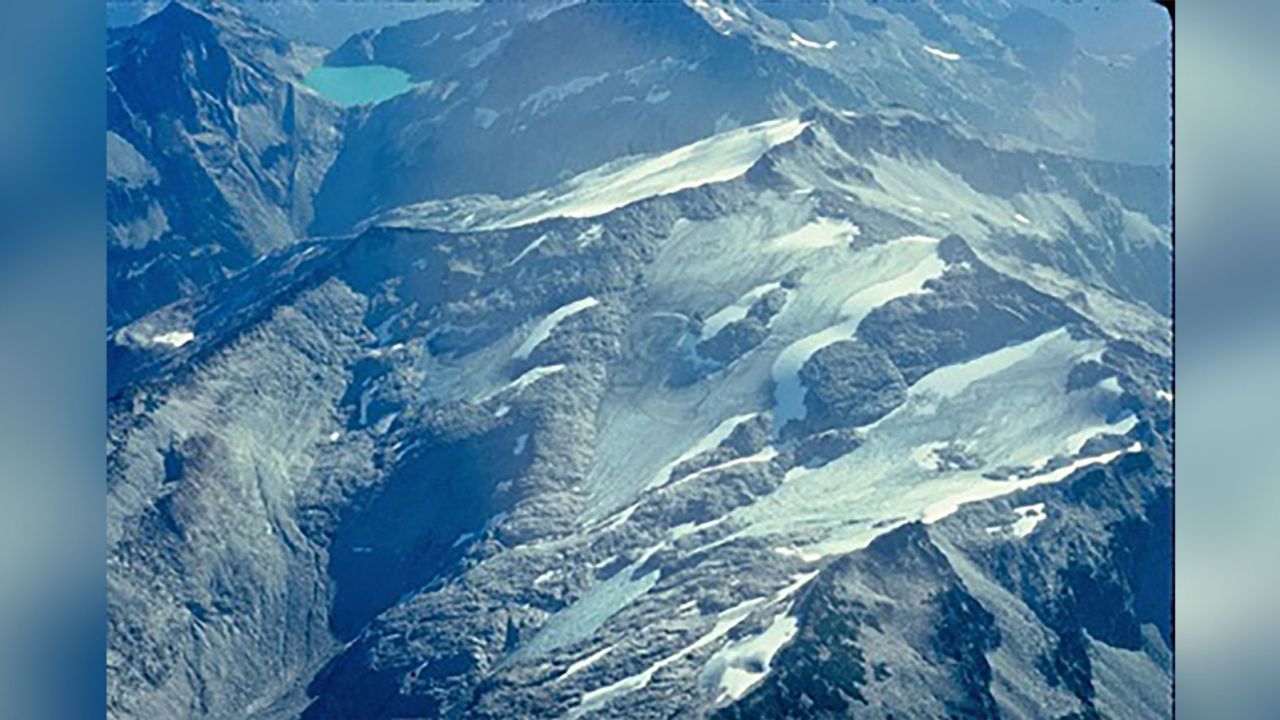Glaciers in Yosemite and Yellowstone are in danger 0:45
(CNN) --
Nestled between the snow-capped ranges of Mount Rainier and Glacier Peak, a significant glacier in Washington state has disappeared after existing filled with ice and snow for millennia, according to a researcher who has monitored it for years.
In this stretch of mountain range in the Washington Cascades east of Seattle, the climate crisis dealt the final blow to Hinman Glacier, the largest in the region, according to Mauri Pelto, a glaciologist at Nichols College.
It's not just the North Cascades that are losing ice.
Researchers recently found that up to half of the planet's glaciers could be lost by the end of the century, even if the world's ambitious global climate goals, including phasing out fossil fuels, are met.
Hinman Glacier seen in 1988 with four separate ice masses.
Credit: Courtesy of Mauri Field
To get an idea of the disappearance of the Hinman Glacier, experts say that an unofficially called "Hinman Lake" has replaced the old glacier, which contains traces of remnant ice masses.
As the lake filled with melting glaciers, it became more difficult for hikers to traverse this part of the range.
Pelto told CNN that he has been visiting and observing Mount Hinman for 40 years.
And in the summer of 2022, as temperatures soared and a relentless dry spell gripped the Northwest, Pelto led a team up the mountain only to see Hinman disappear.
"It has completely disappeared. This was the largest glacier in this part of the range, it was exceptional," Pelto told CNN.
The glacier could reform, he said, "but as we continue to warm up in the future, it will be even less hospitable."
About 50 miles east of Seattle, deep in the Alpine Lakes Wilderness, Hinman and its neighboring glaciers have been critical to the Pacific Northwest salmon population, as well as other aquatic species.
During the hottest and driest periods, Hinman fed the Skykomish River with a considerable amount of cold glacial runoff.
But the flow has slowed significantly as the climate crisis progresses.
advertising
This decrease in summer flow from glaciers and warming freshwater reduces not only the quality of life for salmon, but also that of people who depend on the river, experts say.
Since the 1950s, the primary glaciers that feed the Skykomish River basin have lost about 55% of their surface area.
Last year, Pelto and his team measured that the Columbia Glacier decreased in area by 25%, Foss by 70%, Lynch by 40% and Hinman by 95%.
The "end of the world" glacier, which could raise sea levels several meters, is at its limit, say scientists
David Shean, a professor of civil and environmental engineering who focuses on glaciers at the University of Washington, said he and his collaborators at the US Geological Survey have been working to quantify the changes, including direct measurements of ice volume and the mass change over time to tell the full story.
As glaciers thin and recede, he said, they can form stagnant patches of ice in niches that are less susceptible to temperature extremes.
But these ice patches are often too thin to flow downhill, which is an important criteria for a mass of ice to be classified as a "glacier."
Shean noted that not all of the lingering ice in those niches has disappeared.
But he also said that "it may not technically qualify as a 'glacier' anymore because it's not flowing, and the residual ice will likely disappear entirely in the next decade or so."
Hinman Glacier in 2009 with the newly formed "Hinman Lake" under melting ice.
Credit: Courtesy of Mauri Field
Many glaciers formed during the last Ice Age.
And while glaciologists, including Pelto, aren't sure how long ago Hinman Glacier was created, he found strong evidence that Hinman was older than the eruption of Mount Mazama, which created Oregon's Crater Lake, 7,000 years ago. .
There is still some hope, Pelto said.
For a glacier to form and persist, it needs above-average snowfall accumulation.
Hinman would need to record above-average snowfall abundance in the next few years for it to reform.
But with the rate at which planet-warming pollution is accelerating, these frozen landscapes as we know them may no longer be the same.
"The rate of loss in the last few decades is higher than it was at the beginning of the 20th century," Shean said, noting that smaller glaciers are particularly affected.
"We've seen more ice loss in the last 50 to 70 years for the smaller, lower-elevation glaciers in the North Cascades of Washington, compared to the larger, higher-elevation glaciers like those on Mount Rainier, per example".
Since Pelto began noticing the decline of the Hinman Glacier in 2005, he decided he wanted to document it beyond science and bring in artists, including his daughter Jill, who can capture the changing landscape through paint.
"I really feel that the loss of [glaciers] from the landscape touches people's emotions, and art does that better than scientific data," Pelto said.
"So I've tried to bring in artists every summer."
melting of glaciers

